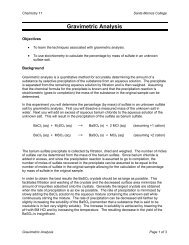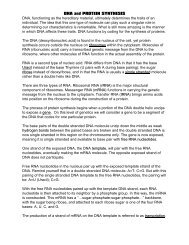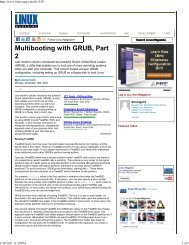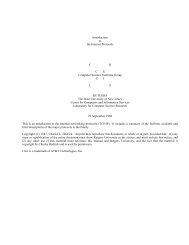You also want an ePaper? Increase the reach of your titles
YUMPU automatically turns print PDFs into web optimized ePapers that Google loves.
NOVEMBER 29, 2007 / APPAREL & FOOTWEAR INDUSTRY SURVEY<br />
22<br />
wholesale, catalog, and Internet sales, as<br />
well as through their own retail stores.<br />
Within the wholesale channel, manufacturers<br />
often try to sell to various types of retailers,<br />
including department stores,<br />
specialty stores, discount stores, and national<br />
chains.<br />
In the past decade, many manufacturers<br />
have opened their own retail stores, reducing<br />
their dependence on the wholesale<br />
channel while potentially increasing sales.<br />
This strategy has benefits — it permits<br />
manufacturers to showcase an entire line of<br />
products, enhance brand awareness, test<br />
new products, and directly collect customer<br />
feedback — but it also carries the risk of<br />
alienating retailers who carry the same<br />
merchandise. Some manufacturers have<br />
also established outlet stores to move older<br />
inventory. For instance, Liz Claiborne operated<br />
399 specialty retail stores and 336<br />
outlet stores as of December 30, 2006.<br />
Specialty retailers the most important channel<br />
Consumers buy apparel and accessories<br />
from a variety of retail outlets. Based on<br />
data from the NPD Group, a market research<br />
firm, specialty stores accounted for<br />
30.8% of apparel dollar purchases by consumers<br />
in 2006, followed by mass merchants<br />
(19.9%), department stores (16.2%), national<br />
chains (14.6%), off-price retailers (7.5%),<br />
direct mail/e-tail pure plays (5.1%), factory<br />
outlets (1.7%), and all other retailers (4.2%).<br />
(“All other retailers” is a category consisting<br />
of warehouse stores, dollar stores, company<br />
stores, and miscellaneous retail outlets.)<br />
APPAREL STORE VS. DEPARTMENT STORE SALES<br />
(In billions of dollars)<br />
180<br />
160<br />
140<br />
120<br />
100<br />
80<br />
60<br />
40<br />
20<br />
0<br />
Apparel stores<br />
Discount<br />
department stores<br />
1995 96 97 98 99 00 01 02 03 04 05 06 E2007<br />
E-Estimated.<br />
Source: US Department of Commerce.<br />
Conventional and national<br />
chain department stores<br />
Differences exist in the distribution mix for<br />
men’s, women’s, and children’s items. For<br />
example, more women’s apparel than men’s<br />
is purchased in specialty and department<br />
stores. Men’s apparel is more prevalent in<br />
discount stores and general merchandise<br />
chains. In the children’s segment, a considerably<br />
higher portion of apparel is purchased<br />
in discount stores. Because children<br />
quickly outgrow their clothing, parents are<br />
less inclined to spend a lot of money on a<br />
single item and, therefore, more inclined to<br />
shop at discount stores.<br />
Fashion is increasingly responsive to the<br />
styles sought by the preteen and teen markets,<br />
whose influence is rising. When promoting<br />
a product, however, manufacturers<br />
and retailers must not only take the user into<br />
account, but the shopper as well. For example,<br />
many men’s apparel items actually are<br />
purchased by women.<br />
Direct to consumer: Internet and catalog<br />
Although the Internet accounted for<br />
about 6.5% of total apparel, footwear, and<br />
accessories sales in 2006, according to research<br />
firm Forrester Research, we believe<br />
that it has strong potential for growth as a<br />
distribution channel. The Internet permits<br />
consumers to shop from anywhere at any<br />
time they wish and to make easy price comparisons,<br />
conveniences that shoppers seem<br />
to appreciate.<br />
Manufacturers use Internet sites for marketing<br />
and informational purposes, as well<br />
as to make sales. The Internet enables apparel<br />
and footwear brands to customize<br />
merchandise to shoppers’ specific needs,<br />
which enables firms to achieve better pricing<br />
along with developing a more emotional<br />
bond with the consumer. Both Nike Inc.<br />
and Polo Ralph Lauren are at the forefront<br />
of this strategy.<br />
Selling by catalog is another important<br />
method of distribution. Before the advent<br />
of the Internet, it was the primary way to<br />
shop at home. Today, however, most retail<br />
apparel brands combine catalog sales with<br />
e-commerce sales under the moniker “direct<br />
to consumer.” This is part of an overall<br />
branding strategy to meet consumers’ needs<br />
24/7 and, thereby, strengthen the emotional<br />
bond that is part of the branding experience.<br />
Catalogs are a form of advertising or direct<br />
marketing, bringing the product to the

















